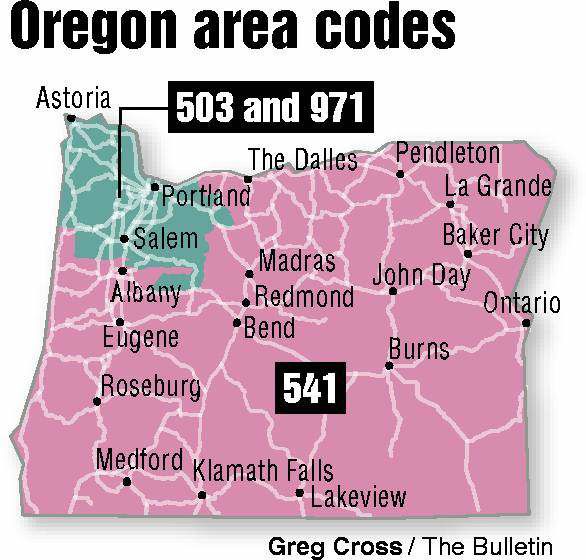541 filling up: Time for a new area code?
Published 5:00 am Thursday, April 24, 2008

- 541 filling up: Time for a new area code?
Central Oregon may have a new area code by 2011, according to Oregon Public Utility Commission spokesman Bob Valdez, who said the commission will consider the proposal in early June.
The decision to add a new code is based on speculation that phone numbers in the 541 area code will be exhausted by the first quarter of 2011, according to the North American Numbering Plan Administration, the government body that manages area codes for the U.S., Canada and various Caribbean nations.
Valdez said the new area code would likely be laid over the existing geographic area served by the 541 area code. New phone numbers requested after the overlay would then be registered with the new area code.
NANPA spokesman Marc Abshire said the telecommunications industry considers overlays the least disruptive method of adding capacity to the nation’s phone system.
A geographic split, Abshire said, can be costly for consumers who receive new area codes as they replace things like business cards, letterhead and signs.
The drawback to the overlay, however, is the need to dial an area code when making a local call. Also known as 10-digit dialing, it is even required when making local calls within the same area code.
“If you’re in a state with one (area) code, it’s a big deal,” Abshire said. “But if you live in areas with high populations, it’s a normal fact of life, it’s what people are used to. The days of seven-digit dialing are gone.”
NANPA has not yet decided on a new area code number.
Originally, all Oregon phone numbers had the 503 area code. In 1995, the majority of the state was given a new area code, 541, and only the state’s northwest corner, which includes Portland and Salem, retained 503.
In 2000, the 971 area code was overlaid atop the same geographic area served by the 503 area code.
Abshire said NANPA had predicted the 541 area code would be exhausted by 2010 but extended the date to the first quarter of 2011 in its most recent report.
Abshire said the demand for new phone numbers is softening due to a number of factors, including the decreasing popularity of pagers, the decreasing need to have a dedicated phone line for an Internet connection and people dropping their home phone lines altogether in favor of cell phones.
Abshire said NANPA also has restructured how it distributes phone numbers to telephone companies, handing them out in blocks of 1,000 instead of 10,000, ensuring that telephone companies use only what they need.
10-digit dialing
For Qwest customers, 10-digit dialing currently works in the 541 area code for local calls, Qwest spokesman Bob Gravely said. It will not be required, however, unless a new area code is overlaid.
The only time a caller needs to dial “1” first, now or when a new area code is overlaid, is for a long-distance call. Perhaps confusingly, calls within the 541 area code — from Bend to Eugene, for example — are considered long distance and require callers to dial 1 plus the area code and phone number.
Ten-digit dialing also would be required for cell phone users making local calls. Local cellular provider Unicel already requires 10-digit dialing for local calls, said spokesman Kipp Meleen.
U.S. Cellular recently sent letters to its local customers in Central Oregon advising them that they will be required to dial the area code for all calls effective May 7.
Bruce Kehe, spokesman for U.S. Cellular, said the company’s decision to require 10-digit dialing is to prepare customers for the eventuality of a new area code. Kehe said the company already requires customers to dial 10 digits when sending text messages.
“They are standardizing their dialing systems so that text messaging and dialing will be the same, so it will get their systems ready to go when … a new area code is overlaid,” Kehe said.
“Many of the company’s markets already have 10-digit dialing.”
Kehe said the initiative applies to U.S. Cellular customers in Oregon, Washington and California. Kehe said the company has 6 million customers nationally, but he did not know how many are in Central Oregon.
Another local cellular provider, T-Mobile, does not yet require 10-digit dialing.
NANPA, based in Sterling, Va., administers the North American Numbering Plan, an integrated telephone numbering plan enacted in 1947. The organization reports to the Federal Communications Commission. State utility commissions, however, are in charge of implementing new area codes, Valdez said.
What’s next
In early June, Valdez said the PUC will open an investigation into the need for a new area code.
It will then hold open houses throughout the geographic area served by the 541 area code and gather public comment, Valdez said, in hope of making a final decision on how to proceed in the fall.
Valdez said the telecommunications industry prefers to overlay new area codes but that the commission could decide to do a geographic split instead. The commission, though, has received few complaints about the 971 area code overlay, he said.






